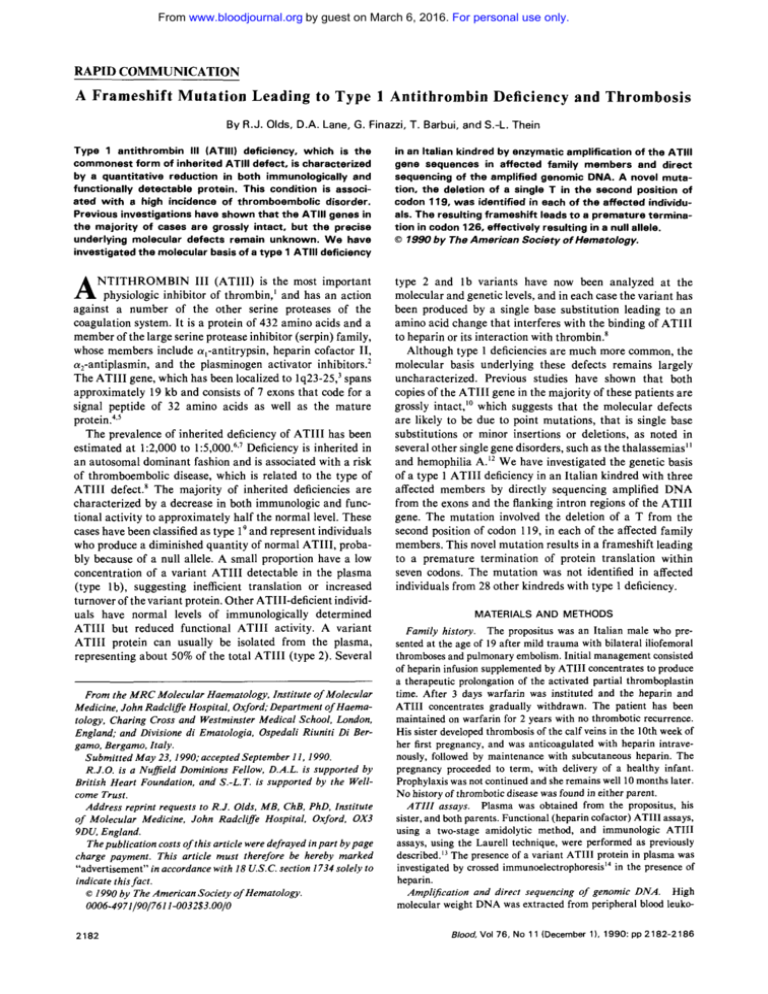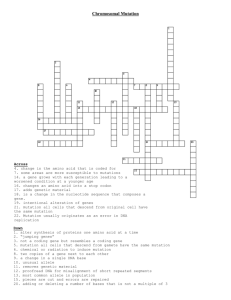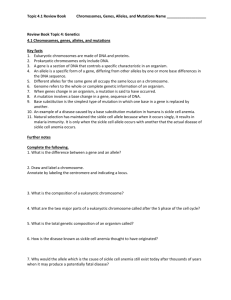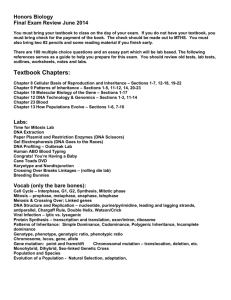
From www.bloodjournal.org by guest on March 6, 2016. For personal use only.
RAPID COMMUNICATION
A Frameshift Mutation Leading to Type 1 Antithrombin Deficiency and Thrombosis
By R.J. Olds, D.A. Lane, G. Finazzi, T. Barbui, and S.-L. Thein
Type 1 antithrombin 111 (ATIII) deficiency, which is the
commonest form of inherited ATlll defect, is characterized
by a quantitative reduction in both immunologically and
functionally detectable protein. This condition is associated with a high incidence of thromboembolic disorder.
Previous investigations have shown that the ATlll genes in
the majority of cases are grossly intact, but the precise
underlying molecular defects remain unknown. W e have
investigated the molecular basis of a type 1 ATlll deficiency
in an Italian kindred by enzymatic amplification of the ATlll
gene sequences in affected family members and direct
sequencing of the amplified genomic DNA. A novel mutation, the deletion of a single T in the second position of
codon 119, was identified in each of the affected individuals. The resulting frameshift leads to a premature termination in codon 126, effectively resulting in a null allele.
0 1990 by The American Society of Hematology.
A
type 2 and I b variants have now been analyzed at the
molecular and genetic levels, and in each case the variant has
been produced by a single base substitution leading to an
amino acid change that interferes with the binding of ATIII
to heparin or its interaction with t h r o m b h 8
Although type 1 deficiencies are much more common, the
molecular basis underlying these defects remains largely
uncharacterized. Previous studies have shown that both
copies of the ATIII gene in the majority of these patients are
grossly intact," which suggests that the molecular defects
are likely to be due to point mutations, that is single base
substitutions or minor insertions or deletions, as noted in
several other single gene disorders, such as the thalassemias"
and hemophilia A.12 We have investigated the genetic basis
of a type 1 ATIII deficiency in an Italian kindred with three
affected members by directly sequencing amplified DNA
from the exons and the flanking intron regions of the ATIII
gene. The mutation involved the deletion of a T from the
second position of codon 119, in each of the affected family
members. This novel mutation results in a frameshift leading
to a premature termination of protein translation within
seven codons. The mutation was not identified in affected
individuals from 28 other kindreds with type 1 deficiency.
NTITHROMBIN I11 (ATIII) is the most important
physiologic inhibitor of thrombin,' and has an action
against a number of the other serine proteases of the
coagulation system. It is a protein of 432 amino acids and a
member of the large serine protease inhibitor (serpin) family,
whose members include a,-antitrypsin, heparin cofactor 11,
a,-antiplasmin, and the plasminogen activator inhibitors.,
The ATIII gene, which has been localized to 1q23-25,3spans
approximately 19 kb and consists of 7 exons that code for a
signal peptide of 32 amino acids as well as the mature
The prevalence of inherited deficiency of ATIII has been
estimated a t 1:2,000 to 1:5,000.6.7Deficiency is inherited in
an autosomal dominant fashion and is associated with a risk
of thromboembolic disease, which is related to the type of
ATIII defect.8 The majority of inherited deficiencies are
characterized by a decrease in both immunologic and functional activity to approximately half the normal level. These
cases have been classified as type l 9 and represent individuals
who produce a diminished quantity of normal ATIII, probably because of a null allele. A small proportion have a low
concentration of a variant ATIII detectable in the plasma
(type 1b), suggesting inefficient translation or increased
turnover of the variant protein. Other ATIII-deficient individuals have normal levels of immunologically determined
ATIII but reduced functional ATIII activity. A variant
ATIII protein can usually be isolated from the plasma,
representing about 50% of the total ATIII (type 2). Several
From the MRC Molecular Haematology. Institute of Molecular
Medicine, John Radcliffe Hospital, Oxford; Department of Haematology. Charing Cross and Westminster Medical School, London.
England; and Divisione di Ematologia. Ospedali Riuniti Di Bergamo. Bergamo. Italy.
Submitted May 23. 1990; accepted September 11, 1990.
R.J.O. is a Nufield Dominions Fellow. D.A.L. is supported by
British Heart Foundation. and S.-L.T. is supported by the Wellcome Trust.
Address reprint requests to R.J. Olds, MB. ChB. PhD. Institute
of Molecular Medicine. John Radcliffe Hospital, Oxford, OX3
9DU. England.
The publication costs of this article were defrayed in part by page
charge payment. This article must therefore be hereby marked
"advertisement" in accordance with 18 U.S.C.section I734 solely to
indicate this fact.
0 I990 by The American Society of Hematology.
0006~4971/90/7611-0032$3.00/0
2182
MATERIALS A N D METHODS
Family history. The propositus was an Italian male who presented at the age of 19 after mild trauma with bilateral iliofemoral
thromboses and pulmonary embolism. Initial management consisted
of heparin infusion supplemented by ATIII concentrates to produce
a therapeutic prolongation of the activated partial thromboplastin
time. After 3 days warfarin was instituted and the heparin and
ATIII concentrates gradually withdrawn. The patient has been
maintained on warfarin for 2 years with no thrombotic recurrence.
His sister developed thrombosis of the calf veins in the 10th week of
her first pregnancy, and was anticoagulated with heparin intravenously, followed by maintenance with subcutaneous heparin. The
pregnancy proceeded to term, with delivery of a healthy infant.
Prophylaxis was not continued and she remains well 10 months later.
No history of thrombotic disease was found in either parent.
ATZIZ assays. Plasma was obtained from the propositus, his
sister, and both parents. Functional (heparin cofactor) ATIlI assays,
using a two-stage amidolytic method, and immunologic ATIII
assays, using the Laurel1 technique, were performed as previously
described.') The presence of a variant ATIII protein in plasma was
investigated by crossed immunoelectrophoresi~'~
in the presence of
heparin.
Amplification and direct sequencing of genomic DNA. High
molecular weight DNA was extracted from peripheral blood leukoBlood, Vol 76, No 11 (December 1). 1990: pp 2182-2186
From www.bloodjournal.org by guest on March 6, 2016. For personal use only.
TYPE 1 ANTITHROMBIN DEFICIENCY
2183
cytes by standard methods. The polymerase chain reaction (PCR)':
was used to amplify specific regions of the ATlll gene for analysis of
known DNA polymorphisms, to produce templates for DNA sequencing, and for hybridization with allele-specificoligonucleotide probes.
Sequencesof the oligonucleotide primers are shown in Table 1. DNA
amplification was achieved by addition of 500 ng of genomic DNA to
the following: ( I ) pairs of oligonucleotide primers (20 pmol each);
(2) IO pL dNTP solution (containing 2 mmol/L of each dATP,
dlTP. dCTP, dGTP); (3) IO pL 1OX PCR buffer ( 5 0 0 mmol/L
KCI. 100 mmol/L Tris-HCI pH 8.3, 25 mmol/L MgCI,); (4) 2 U
Amplitaq DNA polymerase (ILS Ltd, London, England); (5) water
to 100pL. Thermal cycling conditions were denaturation at 94°C for
I minute, annealing at 65OC ( S O T for primers P7 and P8) for 1
minute, and extension at 72°C for 2 minutes. for 30 cycles. The first
cycle was modified to provide a denaturation phase of 1.5 minutes
while in the last cycle the extension temperature was maintained for
10 minutes. PCR product was visualized in I % agarose gels stained
with ethidium bromide and the amplified DNA of interest was
isolated using a unidirectional electroclutor (International Biotechnologies Inc, Cambridge, England). Purified PCR product was
sequenced directly by the dideoxy chain termination method'&
(Sequenase. United States Biochemical, Cleveland, OH) using
nested oligonucleotide primers complementary to the coding and
noncoding strands (Table 1). To analyze the site polymorphism for
Psr 1 within exon 4,'. 16 pL of PCR product was incubated with
excess of the restriction enzyme according to the manufacturer's
instructions, the digested product electrophoresed in 1% agarose and
,Y
visualized by staining with ethidium bromide.
OIigoprobe hybridizarion. Two 19-bpoligonucleotideswere &:nthesized. one complementary to the identified mutation 5'AAGAAGTGGTCTGATCAGA-3'). the other to the normal sequence (5'-AAGAAGTGGATCTGATCAG-3') and were 5'-endlabeled with y"P-dATP (Amersham. England) by a kinase reaction.'8
Amplified DNA of exon 3A sequences from the ATll I genes.of each
of the affected family members and from 17 other individuals with
type I ATlll deficiency, was blotted ontoa nitrocellulose membrane.
The labeled allele-specific oligoprobes were hybridized sequentially
to the membrane, with stringent washes being performed for 5
minutes at 56°C for both probes.'"
Allele-specific priming of PCR. As confirmation and extension
of the results obtained by allele-specificoligoprobe hybridization, the
technique of allele-specific priming of the PCR"' was used to screen
individuals from a total of 28 kindreds with type 1 ATlll deficiency
Table 1. Oligonucleotide Sequences
EXCAl
Prima
sesuws
1
P20
P2 1
5'CTGTmCCVGTCTGTGCCAG
5'-lTGGAGGTCATTCCTGTGAGlC
2
P1
P2
s1
s2
5'-GlTGCAGCCTAGClTAAClTGGCA
5'CGlTGAGGAATCAlTGGAClTG
5'CCACAGCCAAGCCGCGGGAC
5'-TGGAGATACTCAGGGGTGAC
3A
P3
P4
s3
s4
5'-AGTCAGAGACTGACCAGCATGTGC
5'-AGGGGlTCTAACTmAGTCAGC
5%ATGlTAACTAGGCAGCCCACCA
5'CTClTCAGCAGCAAAGCAGTGT
P7
P8
5'4TATAATATGGATATGTCTGTG
5'-ClTCCACTmGGTCAGACTAC
4
Even-numbered primers are complementery to the noncoding strand
odd-numbered primers are complementery to the coding strand.
Abbreviations: P, PCR primer: S, sequencing primer.
Tabla 2. ATlll Functional and Immunologic Quantitation
Wisct
ActMW 1%)
Antigen 1%)
Propositus
Sister
Father
Mother
Normal
53
64
62
98
85-1 15
33
48
56
100
85-125
for the presence of the mutation identified by direct sequencing. The
basis of the method lies in the observation that oligonucleotides that
are not complementary to their templates at the 3'end do not, under
stringent conditions. act as primers in the PCR. Two allele-specific
primers were synthesized with the single base deletion site one base
5' to the 3' end (normal 5'-ATCTGAGAAAACTGATCTGATC-3';
mutant 5'-ATCTGAGAAAACTGATCTGAC-3'). A firther base
mismatch
was incorporated into bo3 the normal and mutant
allele-specificoligonucleotidestoward the 3'-end to promote destabilization of primer-template binding. A common downstream primer
(S'-GGrrGAGGAATCArrGGACTTG-3') was used in the amplification reactions for both alleles. As a test of efficacy of amplification a pair of primers allowing amplification of a fragment from an
unrelated gene (delta globin; upstream primer 5'-GACACACATGACAGAACAGCCAAT-3'. downstream primer 5'-GAAGAGCAGGTAGGTAAAAGAACC-3') was included in each reaction as an
internal control. Each sample was screened in two separate reactions, one for specificamplification of the normal allele and the other
for amplification of the mutant allele. For each series of reactions
(1)
K
5
m
G A T C T G C A
3
T
0
__
B
cu
-
E
!
0
T
C
T
T
C
A
C
C
A
G
A
C
:\
A
C
C
C
T
d
Fig 1. Sequancing gel autoradiograph for the exon 3A coding
strand of the propositus. Each of the four reactions has been
loaded in duplicate, in the order shown, to facilitate reading of the
sequence. The PCR simultaneouslyamplifies the wild-type and the
mutant alleles so that both alleles are sequenced. H both alleles
were normal, only a single band should be present in each ladder.
The arrow indicates the position of the deleted T in the mutant
allele, resulting in a single base shift in one allele beyond the
mutation site; thus the sequences of the two alleles are one step
apart.
From www.bloodjournal.org by guest on March 6, 2016. For personal use only.
OLDS ET AL
2184
DNA of known normal sequence was used as a normal control and
DNA from one of the family members with the mutation was used as
the mutant control. The PCR was performed as described above,
except that the reactions werc performed in a total volume of 25 pL
(with each component being added in one quarter of the quantity
used in a 100 p L reaction). The annealing temperature was 65OC.
Products were visualized as described above.
RESULTS
ATIII ussuys. Results are presented in Table 2. The
functional and immunologic assays of AT111 in the propositus, his sister, and father are consistent with type 1 ATIII
deficiency. The mother’s results are within normal limits. No
variant form of AT111 was detected in the plasma from the
propositus. using crossed immunoelectrophoresis (data not
shown).
ATIII gene polymorphisms. Amplification of a fragment of DNA encoding part of the 5’-untranslated region of
the AT111 gene and exon 1 using primers P20 and P21
produces fragments of 708 or 632 bp because of the presence
of the previously described length polymorphism.m The
propositus and his sister were each homozygous for the
shorter-length allele, while the father was heterozygous for
the short and long alleles. Digestion of the amplified DNA
from the exon 4 region (primers P7 and P8) with f s f I
allowed analysis of a f s f I site polymorphism located within
codon 305.” Amplification using primers P7 and P8 produces
a fragment of 53 1 bp but the presence of the f s r I site results
in two fragments of 325 and 206 bp after digestion with the
enzyme. Each of the family members examined here was
heterozygous for the presence of the fsr I polymorphism.
DNA sequence. The nucleotide sequence of exon 2,
coding for the last 19 residues of the signal peptide and the
first 104 amino acids of the mature protein, was normal.
Similarly, the intron sequences flanking exon 2 were normal.
In exon 3A, deletion of a single T was identified in the second
position of codon I19 in each of the affected individuals, ie,
the propositus, his father, and sister (Fig I). The mutation
was confirmed by sequencing both DNA strands, by allele
specific oligonucleotide hybridization, and by allele-specific
priming of PCR (Fig 2); in each case the results clearly
demonstrate that the affected individuals were heterozygous
for the deletion in codon 119. None of the DNA samples
from the other 28 individuals with type 1 ATlll deficiency
showed amplification with the mutant allele-specific primer,
and they all amplified with the normal allele-specific primer.
Similarly, specific oligonucleotidehybridization did not show
that any of the 17 individuals examined had the mutant
allele.
DISCUSSION
Assessment of AT111 levels in three members of an Italian
kindred confirmed the inheritance of type 1 ATill deficiency.
AT111 levels were approximately 50% of normal in both
antigenic and functional assays. Heterozygosity for the f s f I
1 2 3 4 5 6 7 8 9 1 0 1 1 12
Normal allele
specific primer
Mutant allele
specific primer
-742
-334
-742
-334
bp
bp
bp
bp
Fig 2. Agarose gel demonstratingallele-specHic primingof the PCR for the normal allele (top) and for the mutant allele (bottom). Lane
1. marker 6x174 Mae Ill; 2. normal control; 3 through 6, father, son. and daughter, respectively of the affectedfamily; 8 through 11. other
individualswith type 1 ATlll deticiency: 12. water blank. The upper band of 742 bp in each sample track results from the amplification of a
fregment of the delta globin gene and acts as an internal control of the success of the PCR. Both the normal allelespecific and the mutant
allelaspecific bands of 334 bp are seen in the affected family members (top and bottom lanes). whereas the other individuals(lanes 8
through 11 show amplificstion with the normal allele-specific primer only. This demonstrates that the mutation is present in one of the
ATlll nneles of the affected family members but absent in the other individuals.
From www.bloodjournal.org by guest on March 6, 2016. For personal use only.
2185
TYPE 1 ANTITHROMBIN DEFICIENCY
site polymorphism within the ATIII gene showed that both
copies of the gene in the affected individuals are present and
grossly intact. Such a gross mapping strategy will not detect
small rearrangements within an allele, or disturbance of the
3'-end of the gene, but it can a t least indicate the presence or
absence of both alleles.
We elected to search for the genetic basis of the deficiency
by sequencing amplified D N A of the exons and the flanking
intron regions that code for the mature ATIII protein. A
single base deletion in exon 3A, a T in the second position of
codon 119, was identified in one allele of the affected
individuals. This represents the first report of a point mutation within the region coding for the mature ATIII protein
leading to a null allele. The effect of the deletion is to produce
a frameshift that results in a stop codon at codon 126 (Fig 3),
compared with the normal ATIII protein of 432 amino acids.
The truncated form of the protein was not detectable in the
plasma, suggesting that either the protein is not expressed or
is rapidly degraded. Having characterized the mutation, we
used allele-specific primer amplification to screen 28 other
kindreds with type 1 ATIII deficiency for the codon 119
single base deletion, but the mutation was not identified in
any of the individuals. Results from this technique, and
allele-specific oligoprobe hybridization, confirmed that the
mutation was heterozygous in the affected members of the
Italian family.
One other mutation within the ATIII gene has been
described, in preliminary form,*' in association with a type 1
ATIII-deficient phenotype. This produced an amino acid
substitution within the signal peptide of the ATIII preprotein, but further details of the effect of this mutation have not
been published yet. A previous survey of ATIII gene structure in type 1-deficient patients'' suggested gross deletion or
rearrangement of the gene was an uncommon mechanism of
Exon
1
2
3 A 3B 4
5
6
1
-T
122 123 124 125 126
120 121
His
Phe Phe Phe A h Lys Leu
ne
CAG ATC CAC TTC T E TIT GCC AAA (JTG
CAG ACC ACT TCT TCT 'IT3 CCA AAC TGA
Ser Ser Leu Pro Asn STOP
Gln Thr Thr
118
Gin
Normal
Mutant
119
Fig 3. The deletion of the single T from codon 119 leads to a
frameshift and premature termination signal in codon 126.
ATIII deficiency. Using the simple expedient of screening
the polymorphisms known to be closely linked to the ATIII
gene, we confirmed, as an initial step, that whole gene
deletion was not the mechanism of deficiency in this family,
or in 17 of 28 other kindreds we have examined (Olds RJ,
Thein S-L: unpublished observations, May 1990). By analogy with other single gene disorders, such as the thalassemias"
and hemophilia A,12 likely genetic lesions include point mutations, which result in premature termination of translation
or affect transcription of the gene or processing of the RNA.
The possibility of trans-acting lesions has also been suggested
in ATIII deficiency," although there is no evidence to date to
support this. The present demonstration of a mutation
affecting a single nucleotide suggests that point mutations
may not be an uncommon cause of ATIII type 1 deficiency,
and it seems likely that a variety of mutations will be found.
ACKNOWLEDGMENT
Professor D.J. Weatherall is thanked for his support.
REFERENCES
1. Downing MR, Bloom JW, Mann KG: Comparison of the
inhibition of thrombin by three protease inhibitors. Biochemistry
17:2649, 1988
2. Huber R, Carrel1 RW: Implications of the three-dimensional
structure of a,-antitrypsin for the structure and function of serpins.
Biochemistry 28:895 1, 1989
3. Bock SC, Harris JF, Balazs I, Trent JM: Assignment of the
human antithrombin I11 gene to chromosome 1q23-25. Cytogenet
Cell Genet 39:67, 1985
4. Prochownik EV, Bock SC, Orkin SH: Intron structure of the
human antithrombin 111gene differs from that of other members of
the serine protease inhibitor superfamily. J Biol Chem 260:9608,
1985
5. Bock SC, Marrinan JA, Radziejewska E: Antithrombin I11
Utah: Proline-407 to leucine mutation in a highly conserved region
near the inhibitor reactive site. Biochemistry 27:171, 1988
6. Rosenberg RD: Actions and interactions of antithrombin and
heparin. N Engl J Med 292:146,1975
7. Abildgaard U: Antithrombin and related inhibitors of coagulation, in Poller L (ed): Recent Advances in Blood Coagulation, vol3.
New York, NY, Churchill Livingstone, 1981, p 151
8. Lane DA, Cas0 R: Antithrombin: Structure, genomic organisation, function and inherited deficiency. Ballieres Clin Haematol
2:961, 1989
9. Sas G: Classification of antithrombin I11 deficiencies. Thromb
Haemost 60530, 1988 (letter)
10. Bock SC, Prochownik EV: Molecular genetic survey of 16
kindreds with hereditary antithrombin I11 deficiency. Blood 70:
1273,1987
1 1 . Thein SL, Weatherall DJ: The thalassaemias, in Hoffbrand
AV (ed): Recent Advances in Haematology, vol 5. Edinburgh,
Churchill Livingstone, 1988, p 43
12. White GC, Shoemaker CB: Factor VI11 gene and Hemophilia
A. Blood 73:1, 1989
13. Barbui T, Finazzi G, Rodeghiero F, Dini E Immunoelectrophoretic evidence of a thrombin-induced abnormality in a new
variant of hereditary dysfunctional antithrombin I11 (ATIII Vicenza).
Br J Haematol54561, 1983
14. Laurel CB: Antigen-antibody crossed immunoelectrophoresis. Anal Biochem 10:358, 1965
15. Saiki RK, Gelfand DH, Stoffel S, Scharf SJ, Higuchi R,
Horn GT, Mullis KB, Erlich HA: Primer-directed enzymatic amplification of DNA with a thermostable DNA polymerase. Science
239:487, 1988
16. Sanger F, Nicklen S, Coulson AR: DNA sequencing with
chain terminating inhibitors. Proc Natl Acad Sci USA 745463,
1977
17. Prochownik EV, Markham AF, Orkin SH: Isolation of a
From www.bloodjournal.org by guest on March 6, 2016. For personal use only.
2186
cDNA clone for human antithrombin 111. J Biol Chem 2583389,
1983
18. Thein SL, Wallace RB: The use of synthetic oligonucleotides
as specific hybridisation probes in the diagnosis of genetic disorders,
in Davies KE (ed): Human Genetic Diseases, A Practical Approach.
Oxford, UK, IRL, 1986, p 33
19. Newton CR, Graham A, Heptinstall LE, Powell SJ, Summers C, Kalsheker N, Smith JC, Markham A F Analysis of any
OLDS ET AL
point mutation in DNA. The amplification refractory mutation
system (ARMS). Nucleic Acids Res 17:2503, 1989
20. Bock SC, Levitan DJ: Characterisation of an unusual DNA
length polymorphism 5’to the human antithrombin 111gene. Nucleic
Acids Res 113569, 1983
21. Perry DJ, Daly ME, Carrel1 RW, Borg J-Y: Molecular
characterisation of 14 ATIII variants using the polymerase chain
reaction. Br J Haematol74:16, 1990 (abstr, suppl)
From www.bloodjournal.org by guest on March 6, 2016. For personal use only.
1990 76: 2182-2186
A frameshift mutation leading to type 1 antithrombin deficiency and
thrombosis
RJ Olds, DA Lane, G Finazzi, T Barbui and SL Thein
Updated information and services can be found at:
http://www.bloodjournal.org/content/76/11/2182.full.html
Articles on similar topics can be found in the following Blood collections
Information about reproducing this article in parts or in its entirety may be found online at:
http://www.bloodjournal.org/site/misc/rights.xhtml#repub_requests
Information about ordering reprints may be found online at:
http://www.bloodjournal.org/site/misc/rights.xhtml#reprints
Information about subscriptions and ASH membership may be found online at:
http://www.bloodjournal.org/site/subscriptions/index.xhtml
Blood (print ISSN 0006-4971, online ISSN 1528-0020), is published weekly by the American
Society of Hematology, 2021 L St, NW, Suite 900, Washington DC 20036.
Copyright 2011 by The American Society of Hematology; all rights reserved.









